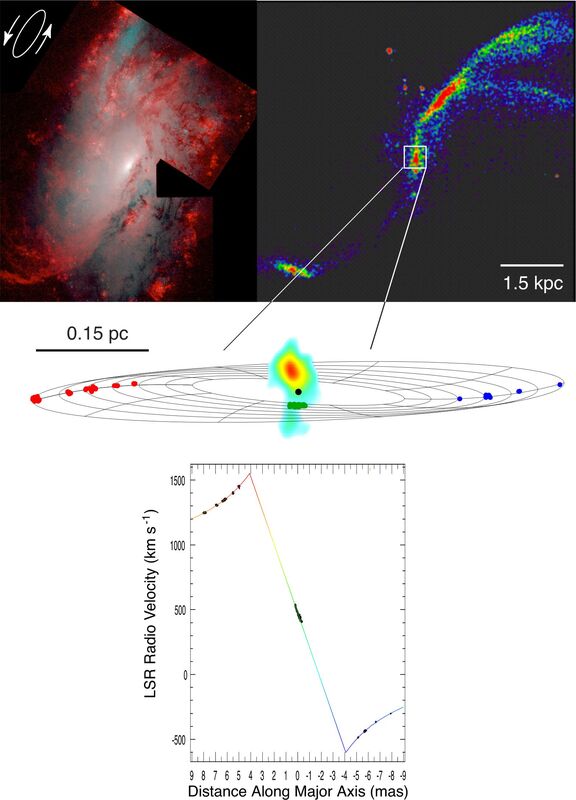NGC 4258 Massive Black Hole & Accretion Disk
Description
NGC 4258 is a Seyfert galaxy in the constellation Ursa major. It is generally agreed to have at its heart a supermassive black hole some 39 million times more massive than the Sun. Gas orbiting this black hole has formed a warped disk nearly two light years in diameter. By measuring extremely small shifts in the positions of H<sub>2</sub>O masers (water vapor that amplifies microwave radio emissions) located in this disk, scientists have been able to measure the distance to this galaxy as 23.5 million light years, a measurement the scientists say is accurate to within a million light years. The disk is viewed nearly edge-on from Earth and orbits the black hole at a speed of more than 2 million miles per hour. Using the Very Long Baseline Array, the astronomers observed the Doppler shift of the masers at the disk's sides at 4 to 8 month intervals over more than three years. This shift, or "proper motion," combined with previous observations in which astronomers had measured the speed of the orbiting disk and ascertained the mass of the black hole, has enabled the scientists to make the distance determination. Previous observations using Cepheid variable stars and the Hubble Space Telescope had set the distance at 27 or 29 million light years. The difference in these two distance determinations will make a significant impact on future calculations of the size and age of the Universe. For more information see the NRAO Press Release <a class=navig href=http://www.nrao.edu/pr/1999/distance/>Radio Astronomers Set New Standard for Accurate Cosmic Distance Measurement.
Upper Left: Ground-based Halpha+[NII] (red) and HST continuum F547M+F791W (blue/green) images of NGC 4258 (from Cecil, Greenhill, DePree et al. 2000). The cartoon in the upper corner indicates the direction of rotation for the galactic stellar disk. The Halpha+[NII] light traces stellar and nonstellar (anomalous) spiral arms. The anomalous arms are related to outflow from the AGN. They are sources of synchrotron emission and are prominent at radio wavelengths. Upper Right: Compiliation of VLA A+B+C-array observations at 20cm (1.4 GHz), also presented in Cecil et al. 2000. Middle: Data and model for accretion and outflow structures in the central parsec. Red, blue, and green filled circles show the distribution of water (maser) emission mapped with the VLBA (Moran et al. 1995; Herrnstein et al. 1997; Moran et al. 1999). The masers may be used as point-like test particles whose positions and line-of-sight velocities can be fit with high accuracy to a simple geometric model of a thin, warped accretion disk (wireframe). The central mass is estimated to be 39 million solar masses, confined within about 0.1 pc. In this way, VLBA study of NGC4258 provided the first conclusive evidence of a massive black hole in the nucleus of another galaxy. The VLBA has also detected the base of the anomalous arms, in the form of a flat spectrum radio jet. A 22 GHz continuum image is shown in falsecolor. The black dot at the center of the image indicates the fit location of the central black hole. Bottom: Fully resolved rotation curve of the accretion disk. The velocities of the masing regions are shown with the best fit rotation curve, which obeys Kepler's Law to better than 1 percent. At this time, no other accretion disk has been studied in as great detail (via direct imaging) on as small scale. For type-2 AGN, there is no means other than interferometric imaging of water masers to map accretion disks at sub-parsec radii.
Creator
Legacy Astronomical Images
Rights
NRAO/AUI/NSF does not hold full copyright for this image. Contact the archivist for details.
Type
Legacy Astronomical Image
Object Name
NGC4258
Photo Credit
L Greenhill (Harvard-Smithsonian Center for Astrophysics)
Investigators
J. M. Moran, L. J. Greenhill, J. R. Herrnstein
Telescope
Very Large Array (VLA)
Effelsberg
HST
Mayall 4-m
Observation Date
1999-00-00
Type of Observation
spectral line
Center of Image
RA 12:18:57.520, Dec: 47:18:14.200 (J2000)
Field of View
0.050000 x 0.050000 degrees
Link to journal article
Notes
Contact the archivist for a high resolution tif of this image.
Series
Active Galactic Nuclei Series
Unit
Seyferts Unit
Citation
Legacy Astronomical Images, “NGC 4258 Massive Black Hole & Accretion Disk,” NRAO/AUI Archives, accessed June 14, 2025, https://www.nrao.edu/archives/items/show/33408.

